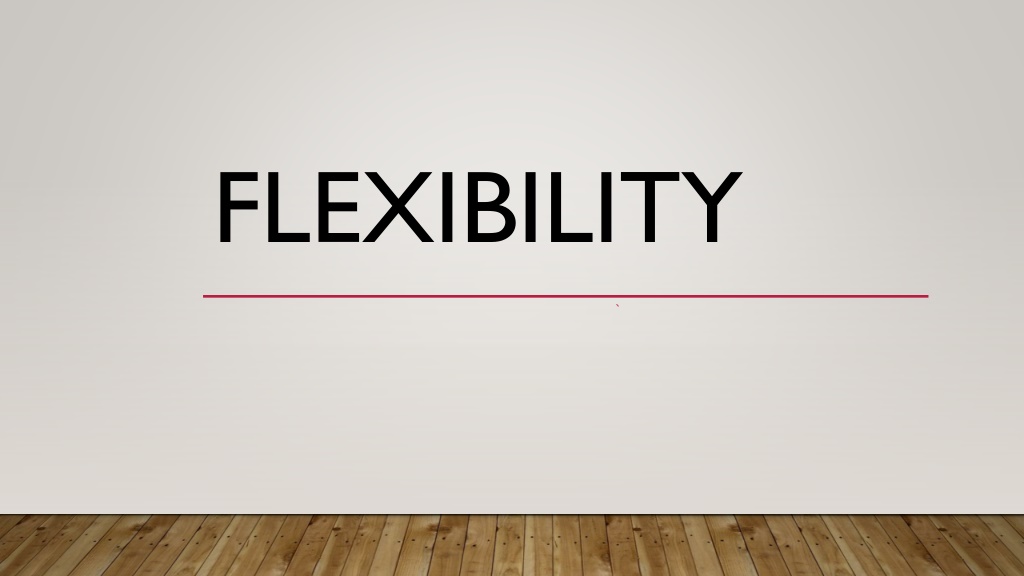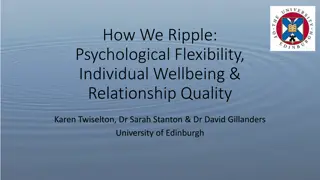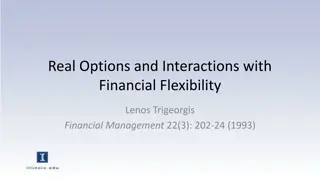Understanding Flexibility: Types, Methods, and Benefits
Flexibility is the ability of joints to move within their maximum range, crucial for overall health and sports performance. It can be passive or active, and there are various methods to enhance it such as ballistic, static stretching, dynamic stretching, and proprioceptive neuromuscular facilitation. Improving flexibility contributes to better movement, injury prevention, and overall well-being.
Download Presentation

Please find below an Image/Link to download the presentation.
The content on the website is provided AS IS for your information and personal use only. It may not be sold, licensed, or shared on other websites without obtaining consent from the author. Download presentation by click this link. If you encounter any issues during the download, it is possible that the publisher has removed the file from their server.
E N D
Presentation Transcript
FLEXIBILITY It is the ability of joints to move in maximum range. In other words, this is the range of a joint to move maximum.
Types of Flexibility There are various types of flexibility that are described below. 1. Passive Flexibility: The ability to do movements with greater distance with external help is called passive flexibility, e.g., stretching exercises with the help of a partner. Passive flexibility is always more than active flexibility. In fact, passive flexibility is the foundation for active flexibility.
2. Active Flexibility: Active flexibility is the ability to do movement for a longer distance without external help, e.g., to do a stretch without the help of a partner. Active flexibility can further be divided into two parts- static flexibility and dynamic flexibility. (a)Static Flexibility: Static flexibility is usually required by a sportsperson when he/she remains in static position, e.g., in diving, sitting, lying and starting position in various sports. (b)Dynamic Flexibility: Dynamic flexibility is needed for doing movements with greater distance when an individual is in motion. Both types of flexibilities are essential for a general individual and for a sportsperson. Flexibility can be achieved by stretching exercises. Before performing stretching exercises one should do gentle jogging or slow running (warming-up).
Methods to Improve Flexibility Flexibility can be improved or developed effectively with the help of following methods. 1. Ballistic Method: In ballistic method, the movement is performed with a swing in a rhythmic way. The related joint is stretched with a swing. The stretching exercise can be performed rhythmically with a count. At each count, the joint is stretched to the maximum limit and then it is again flexed. Before performing such exercise, appropriate warm-up is essential because there are maximum chances of over-stretching of a joint. 2. Static Stretching Method: Static stretching method involves gradually easing into the stretch position and holding the position. The amount of time a static stretch is held depends on one's purpose. If it is a part of cool down, then the stretch should be held for 10 seconds. If it is to improve the range of flexibility then hold it for 30 seconds. In static stretching, it is advised to move further into the stretch position as the stretch sensation comes to a lower level.
3.Dynamic Stretching Method: Dynamic stretching consists of controlled leg and arm swings that take you gently to the limit of your range of motion. If an event requires a dynamic movement, it is appropriate to conduct dynamic stretching. exercises. Start with the movement at half speed for a couple of repetitions and then gradually work up to full speed. 4.Proprioceptive Neuro-Muscular Facilitation Technique: This technique or method is used by advanced sportspersons for gaining flexibility. PNF involves the use of muscle contraction before the stretch in an attempt to achieve maximum muscle relaxation. The following procedure is used for PNF technique.
i. You move into the stretch position so that you may feel the stretch sensation. ii.Your partner holds the limb in this stretched position.(iii) iii.You then push against your partner by contracting the antagonistic muscles for 6to 10 seconds and then relax. During the contraction, your partner aims to resistany movement of the limb. iv.Your partner then moves the limb further into the stretch until you feel the stretch sensation. v. Then again go back to no.(ii) to repeat the same procedure. Repeat the whole procedure for 3 to 4 times.
TO BE CONTINUED THANK YOU























